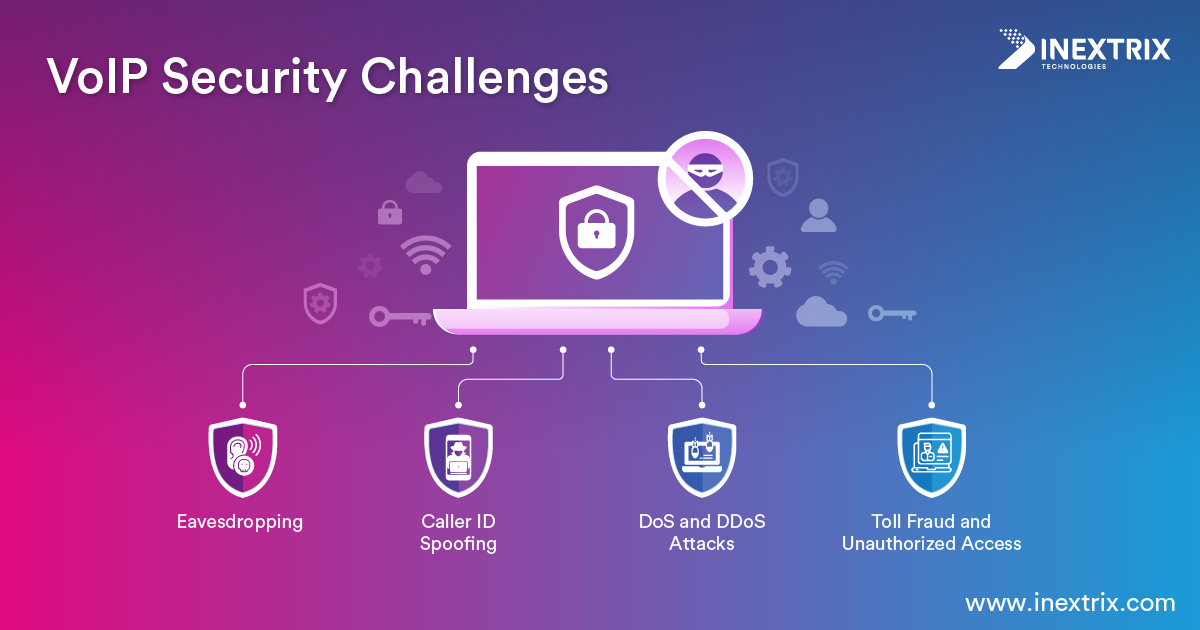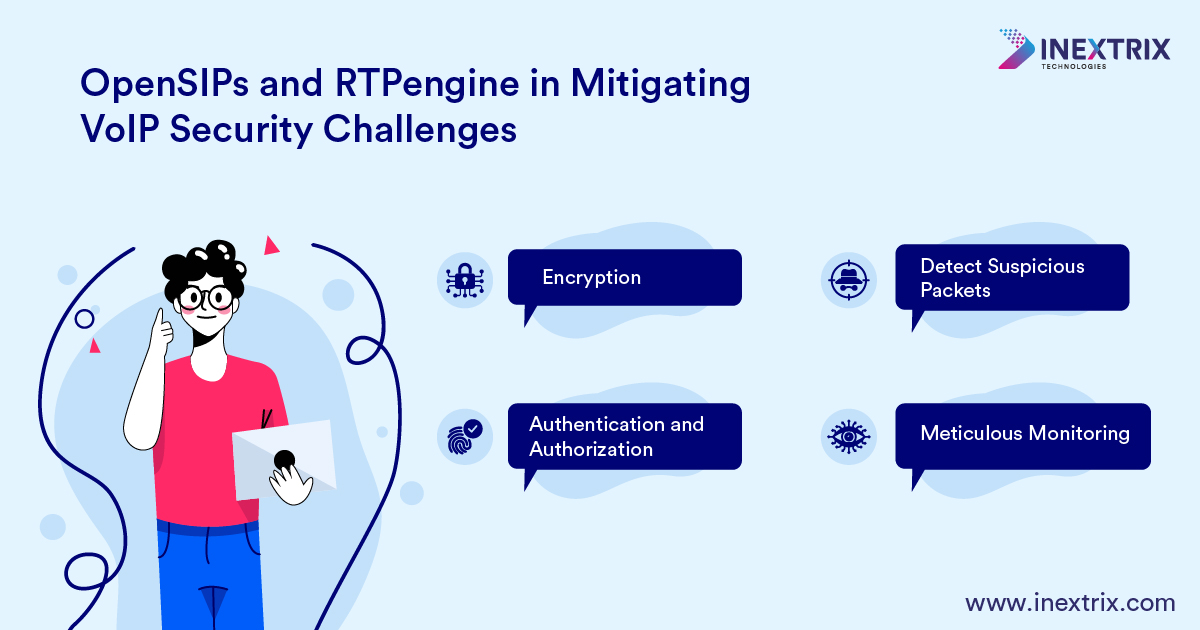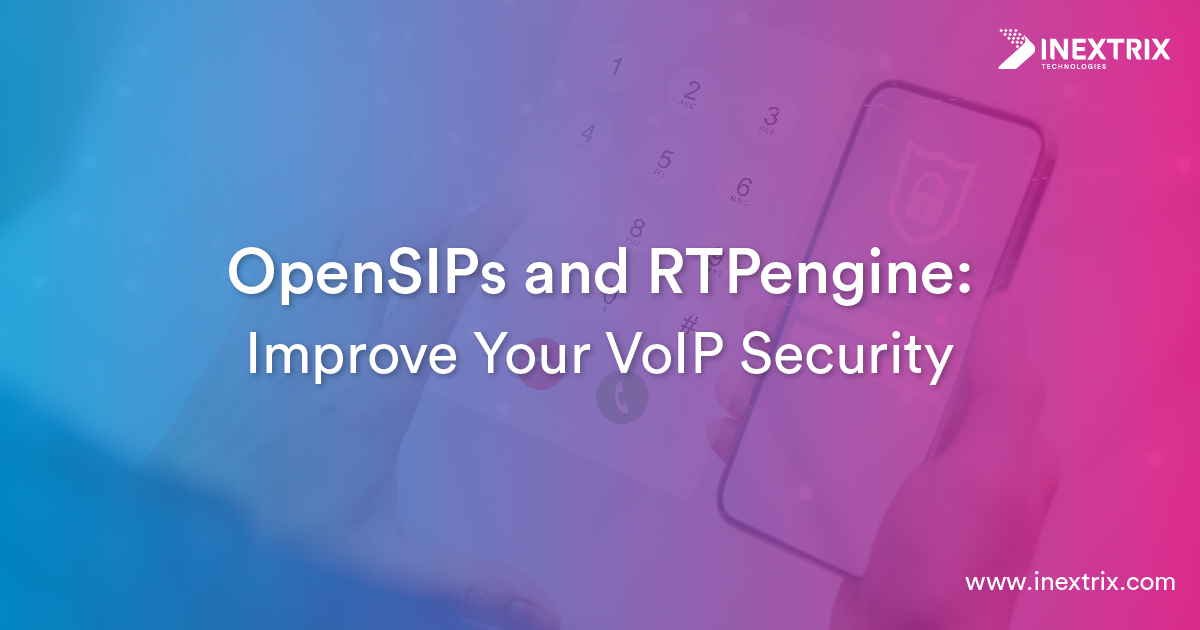Voice over Internet Protocol (VoIP) has been a buzzword for many years. Its feature-rich communication tools and cheaper cost of calls make it preferable for all types of users. In businesses, communication is very important. Therefore, it becomes necessary to use reliable, enriching, and cost-effective communication mediums. Some of the popular VoIP based business communication tools are calling card solutions, IP PBX solutions, and more. VoIP technologies like OpenSIPs RTPengine are contributing to building powerful and secure communication tools.
The popularity of VoIP based communication solutions has been growing in leaps and bounds because of affordability. Similarly, threats and risks of data stealing, or privacy compromise have also increased. In VoIP communication, several challenges arise because of the direct use of internet lines for calling and data transmission. For hackers, it is easy to intercept lines and perform fraud or still data. This makes it necessary to use the right technology, tools, and strategy to stay protected from major VoIP security challenges.
We will cover an insightful discussion on this topic in this blog post, which will include:
1. Four Major VoIP Security Challenges

VoIP security has been one of the major challenges for businesses that offer these solutions and consumers that are using them. Certainly, there are several tools, technologies, software, protocols, and best practices invented to consolidate VoIP security to mitigate major risks and challenges. However, it is still necessary to know the major threats on your VoIP network so you can make more conscious decisions. Furthermore, it can help in defining a better strategy.
To help you understand the major and known threats, we have briefed four major challenges related to VoIP security.
Eavesdropping
It is one of the major privacy concerns. This concern arises due to a major loophole in the VoIP security network. In any VoIP network, all data is transmitted over internet lines. Therefore, it is straightforward for hackers to intercept the lines. Hackers can do it for different reasons like stealing information, overhearing a conversation, and more. This can cause major privacy-related concerns. Moreover, as it is very easy to intercept an internet line, it has been a headache for service providers.
Caller ID Spoofing
It is one more known security threat that scares VoIP networks. It is a kind of identity fraud. The attacker pretends to be someone else by flashing a known caller ID on the screen of the call recipient. The main intention of these attackers is to steal money by presenting themselves as a government body or someone they know. This kind of attack may also steal some sensitive information to further damage the customer. Therefore, it becomes necessary to focus on improving the standards of VoIP network security.
Upgrade Your VoIP Security Now! Harness the Power of OpenSIPs and RTPengine for Unparalleled Protection.
This threat is so severe that the US government has made one of the security mechanisms STIR/SHAKEN compulsory. If you are unaware of the STIR/SHAKEN mechanism, then we have a complete guide on it, here. This blog post provides complete insight into this topic.
DoS and DDoS Attacks
Several known VoIP threats cause different implications for the VoIP network and business. DoS (Denial of Service) and DDoS (Destructive Denial of Service) are two common VoIP challenges. Almost all VoIP service providers face DoS and DDoS attacks. Attackers send massive traffic to the VoIP networks to fail the service or crash the server. The effect of DoS and DDoS attacks is catastrophic for VoIP service providers.
Toll Fraud and Unauthorized Access
It is another major VoIP security challenge hitting VoIP service providers hard. Attackers gain access to expensive numbers or lines and then make many international calls through expensive lines. This can result in financial loss for a service provider because he has to pay for call minutes.
2. Introduction of OpenSIPs
Many VoIP companies are building telephony systems with OpenSIPs, but what is this technology all about? Let’s take a quick look.
It is one of the open-source VoIP technologies. It is robust. Moreover, it can manage concurrent calls. It is a SIP proxy server. Therefore, VoIP businesses often use it as a proxy server. Most importantly, it manages the jobs of receiving SIP requests and evaluating them. Moreover, it also categorizes these SIP requests based on predefined criteria defined in the software. For a variety of reasons, OpenSIPs development services are in use. Certainly, one of the major utilities of the development services is developing security solutions such as fraud detection and management solutions.
It is known as an SIP proxy server. But it is amazing in providing secure routing services in the VoIP network. As a result, the top companies use it to build secure routing engines. It is a highly flexible platform, which provides an open sky of opportunities to implement any functionality. Therefore, several security tools are built using OpenSIPs.
3. Introduction of RTPengine
RTPengine is also a proxy. Its role is to provide a proxy for RTP traffic and other media traffic of UDP. The traffic mostly transmits through IPv6 and IPv4. Depending on the application, the use of RTPengine is defined. The major utility is to fill the chasm between different interfaces and networks.
RTPengine has different roles to play. It has an interesting role in improving the security of a VoIP network by overcoming challenges. The development companies use it to develop a solution for transcoding to enable different networks with different codecs to interact with each other easily. Moreover, it helps in recording and analyzing live streams for consolidating security. It is amazing in QoS.
4. Role of OpenSIPs and RTPengine in Mitigating VoIP Security Challenges

OpenSIPs RTPengine is a powerful combination. These two platforms are in use in several security platforms. In multiple ways, the programs built using OpenSIPs and RTPengine boost the security and protection of the platform. Let’s explore the major ways of using this excellent combination of technology tools for consolidating security.
Encryption
Encryption is one of the top ways of preventing common VoIP security challenges like eavesdropping and data stealing or privacy concerns. Both OpenSIPs and RTPengine have a pivotal role to play here. As a result, an added layer of security has become part of several VoIP businesses.
The experts of OpenSIPs can create an algorithm to enforce the encryption of signaling. This encryption goes via SIP through TLS (Transport Layer Security). RTPengine supports SRTP (Secure Real-time Transport Protocol). It is another layer of secure media transmission for consolidated security. This helps in encrypting the whole line and secure data transmission. Certainly, it makes it difficult for attackers to intercept. Moreover, they would not be able to deceive data even if by any chance they succeed in intercepting the line.
Authentication and Authorization
OpenSIPs has an awesome functionality of introducing authentication in any VoIP network using digest authentication. While building telephony systems with OpenSIPs, programmers can add this mechanism to authenticate all users and sessions for added security checks. On the other hand, RTPengine is capable of enforcing strict session parameters for identity validation.
As a result, VoIP solutions will easily authenticate and authorize caller IDs to protect customers from identity fraud and caller ID spoofing.
Detect Suspicious Packets
OpenSIPs and RTPengine both have an inbuilt feature of identifying suspicious data packets entering the network. OpenSIPs is renowned for identifying suspicious traffic patterns. On the other hand, RTPengine enforces strict session parameters for mandatory identity validation.
These characteristics of these technologies help in preventing common DoS and DDoS attacks. The experts will implement OpenSIPs RTPengine functionalities to detect unusual traffic and block it.
Meticulous Monitoring
OpenSIPs and RTPengine have further features to prevent other common attacks like toll fraud and unauthorized access to the system. RTPengine performs outstandingly in tracking all calls to monitor traffic patterns in real-time. Additionally, it will also perform call recording to provide further features to monitor calls and system traffic. Moreover, OpenSIPs are remarkable in preventing unauthorized usage of the system by implementing access control policy enforcement.
5. Concluding Notes
In a nutshell, VoIP traffic is prone to major attacks and security threats. Whether you are a VoIP service provider or a VoIP consumer, you are likely to get attacked by attackers with malicious intent. You cannot stop them from causing attacks. However, by using OpenSIPs RTPengine, you can build a consolidated and secure VoIP system and infrastructure. You can withhold all common and well-known VoIP attacks to safeguard the interests of your business and your customers.
We have provided RTPengine and OpenSIPs development services to our clients for several years. We can help you build a more reliable and more secure VoIP platform that can protect your business from several challenges. For example, DoS, DDoS, toll fraud, caller ID spoofing, and more.
If you are interested in learning more about our expertise in OpenSIPs RTPengine, then contact us now!
